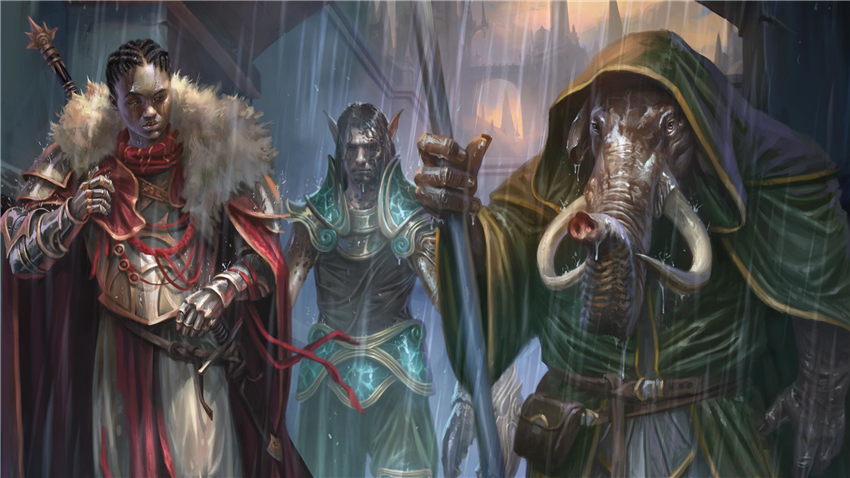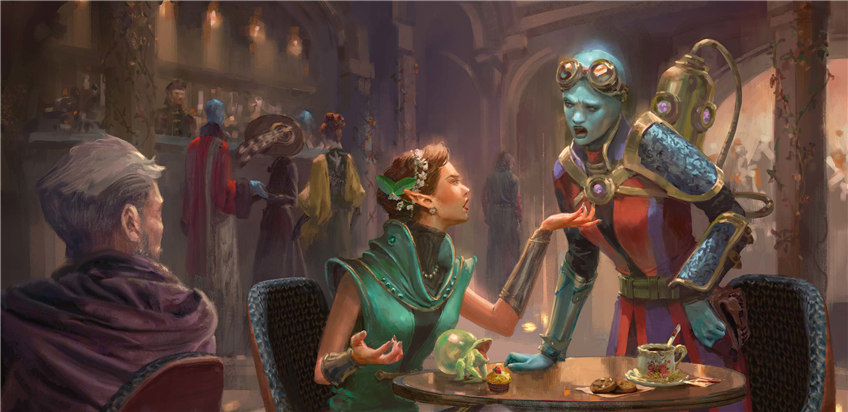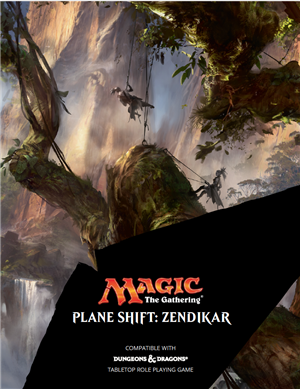Fans of D&D, welcome to the world of Magic: The Gathering. Likewise, Magic players, welcome to the D&D Multiverse. Guildmaster’s Guide to Ravnica is the newest D&D setting book, and the first hardcover Magic: The Gathering × D&D crossover. Here’s a basic primer on the plane and the contents of the book so you can slide right into your first campaign in the city-plane of Ravnica.

The D&D Perspective: What’s Familiar, What’s New?
I’m a D&D player who’s relatively new to Magic: The Gathering, even though the game’s been around longer than I have. (Not much longer, but still.) I suspect that many readers (dare I guess most?) of Guildmaster’s Guide to Ravnica will be D&D players encountering the lore of Magic: The Gathering for the very first time.
The first thing you’ll realize is that Guildmaster’s Guide to Ravnica is very much a D&D book. Ravnica may be a setting borrowed from another game, and there may be some aesthetic tips of the hat to Magic (such as the names of certain monster attacks being borrowed from Magic cards), but it never strays far from the thematic and mechanical core of Dungeons & Dragons. If you’re worried about having to learn a new spell system and how to use mana in your D&D game, let this set those fears at ease.
As a setting, Ravnica is reminiscent of the city of Sigil in the Planescape campaign setting because of its extraplanar nature, its urban environment, and its constantly feuding guilds. It is also a society where magic and magic-derived technology are commonplace, making comparisons with the Eberron campaign setting inevitable. Both Planescape and Eberron adventures could, with some retooling, fit snugly in the city-plane of Ravnica. Similarly, Waterdeep: Dragon Heist could be adapted to Ravnica, if you were in search of a setting even more fantastical than the city of Waterdeep.
Ravnica is defined by the conflicts and alliances between 10 powerful guilds. In Magic: The Gathering, each of these guilds was represented by a combination of two color types. The Boros Legion, for instance, was represented by the colors of Red and White, whereas the Golgari Swarm was represented by Black and Green. In Magic: The Gathering, the five colors of mana are more than just a core game mechanic, they are also the backbone of character philosophy and motivations, like an abstract alignment system. “Pie Fights,” an article by Magic’s head designer Mark Rosewater, is a good overview of the game’s Color Pie.

The Magic Perspective: How’s the Adaptation?
Magic: The Gathering has an incredibly rich story, despite the fact that its gameplay is completely divorced from its lore. And since Guildmaster’s Guide to Ravnica is a D&D book, Magic fans are counting on the lore of Ravnica to live up to their expectations. From an outsider’s perspective, I’d say it does so—and makes it look easy. Not only does Guildmaster’s Guide introduce the lore of Ravnica to the game in a compelling and clear way, its character creation chapter makes choosing which guild your character will belong to a fun and engaging process. People who love figuring out which Hogwarts house they would be in will have a blast with this system.
Magic’s story is mostly told through the experience of Planeswalkers, but translating Magic’s lore into D&D terms brings the action to street level. This might come as something a shock, since Magic’s most notable characters are very powerful in D&D terms. The Magic equivalent of a 1st-level D&D character is something like a Glory Seeker. A simple card with a modest casting cost, a modest statline, and no real traits to speak of. Named Magic characters, like Planeswalkers, or even just high-cost named creatures, are more likely to be at least 5th level or higher. Since Planeswalkers have the one-in-a-million ability to travel across planes and require incredibly specialized training, a Planeswalker should probably be no lower than 10th level.
Fortunately, Ravnica is especially well-suited to handling to handling low-ranking characters growing into powerful characters who can shake the foundations of a plane. If you start a Ravnica campaign at 1st level, there’s no way you’re going to be playing a mage of Jace Beleren’s caliber. Not yet, anyway. Odds are, a 1st-level character is a grunt in their guild, an outcast from society, or some other lowly person. Think of “street-level” superhero shows like Jessica Jones, rather than The Avengers. Becoming a powerful and notable person within Ravnica—perhaps even a Planeswalker—is something to aspire to as you gain levels.
Guildmaster’s Guide to Ravnica takes place in something of an alternate timeline. Or rather, your adventures using this book will create an alternate timeline. This book picks up where the last Ravnica set, Dragon's Maze, left off, so the the events of Guilds of Ravnica, the latest Ravnica storyline, have not yet come to pass. I urge you to break from Magic canon as much as you like. If your story doesn’t involve Nicol Bolas’s ambitions, for instance, simply remove him from the picture. He’s lost interest in Ravnica, or he was attacked by other Planeswalkers and needs to retreat and regroup for a few years. Chapter 4: Creating Adventures is geared towards helping you create fun and thematic stories for your group in a way that celebrates the elements that make Ravnica unique, while giving you freedom to deviate from canon when necessary.
You’ll also enjoy seeing Magic artifacts and creatures translated into D&D terms. Cards like Pariah’s Shield and Rakdos Riteknife appear as magic items that your characters can find in their adventures—though both of those particular items are tremendously rare. It’s fun to see how these cards’ mechanics translated into D&D game mechanics—I think the translation is rather smooth! Similarly, all of the Ravnican guild leaders, as well as dozens of creatures like Deathpact Angels and Fluxchargers appear as fully statted-out monsters in the back of the book.
One thing that you may notice while playing is that the D&D magic system is very foreign to Magic’s worldbuilding. Since the “magic system” of Magic: The Gathering is literally the card game itself, that system won’t quite work in a D&D setting. Your character is just one card in the deck of a Magic player conducting a Planeswalker duel, so to speak. Maybe someone will come up with a new magic system that better fits Magic: The Gathering-flavored D&D. Perhaps it will even use cards and mana! If you’re feeling inspired, please leave a comment with your experiments below!

Further Reading for Playing D&D in a Magic: The Gathering Setting
If you want to hop between worlds like Jace Beleren, Nissa Revane, Saheeli Rai, and other Planeswalkers, lead designer of Guildmaster’s Guide to Ravnica James Wyatt has also led design on “Plane Shift,” a series of free PDFs adapting some of Magic’s most celebrated settings for use in a D&D campaign.
Each “Plane Shift” PDF is designed to supplement its respective Magic: The Gathering artbook. For instance, Plane Shift: Innistrad is a supplement to the lore and art provided in The Art of Magic: The Gathering - Innistrad. So far, six Plane Shift titles have been created:
 Plane Shift: Amonkhet, a setting inspired by the gods and pharaohs of ancient Egypt.
Plane Shift: Amonkhet, a setting inspired by the gods and pharaohs of ancient Egypt. - Plane Shift: Dominaria, Magic’s original setting. This world was ravaged by rifts torn in the fabric of space and time, and has only just begun to heal from its magical apocalypse.
- Plane Shift: Innistrad, a gothic horror setting topped with a generous dollop of cosmic horror. Contains advice on how to adopt D&D’s gothic classic Curse of Strahd to the Innistrad setting.
- Plane Shift: Ixalan, a setting inspired by the myths and legends of South and Central America. Do battle with pirates, thwart would-be conquerors, and strike deals with cunning merfolk. A perfect place to set Tomb of Annihilation. A companion adventure, X Marks the Spot, is also available for free.
- Plane Shift: Kaladesh, a setting inspired by steampunk and the dream of an uncolonized India. Magic is rare, but technology powered by a magical power known as aether is common here. Consider relocating Embers of the Last War or other Eberron campaigns here.
- Plane Shift: Zendikar, a setting inspired—aptly enough—by D&D’s brand of high fantasy adventure! Ancient ruins filled with treasure are ripe for plunder; try adapting adventures from Tales from the Yawning Portal to this world!
Finally, to see a D&D game set in Ravnica in action, check out Ravnica: The Broken Pact, a livestreamed game run by Reuben Bresler (@moxreuby) on the Saving Throw Show Twitch channel, or check their YouTube archive to see past episodes.
Special thanks to Simon Irving for introducing me to the lore of Magic: The Gathering several months ago and lending me his considerable knowledge of the state of Ravnica during the writing of this article.
 James Haeck is the lead writer for D&D Beyond, the co-author of Waterdeep: Dragon Heist and the Critical Role Tal'Dorei Campaign Setting, the DM of Worlds Apart, and a freelance writer for Wizards of the Coast, the D&D Adventurers League, and Kobold Press. He lives in Seattle, Washington with his partner Hannah and their Horned Cheetah Mei, and their Noble Panther Marzipan. You can usually find him wasting time on Twitter at @jamesjhaeck.
James Haeck is the lead writer for D&D Beyond, the co-author of Waterdeep: Dragon Heist and the Critical Role Tal'Dorei Campaign Setting, the DM of Worlds Apart, and a freelance writer for Wizards of the Coast, the D&D Adventurers League, and Kobold Press. He lives in Seattle, Washington with his partner Hannah and their Horned Cheetah Mei, and their Noble Panther Marzipan. You can usually find him wasting time on Twitter at @jamesjhaeck.








-
View User Profile
-
Send Message
Posted Nov 14, 2018I might not be a majority, but I find D&D through MTG and it's been an amazing experience. As I follow MTG news, these Plane Shift articles by James Wyatt are truly great read; each describes one of MTG's unique settings and how that translates into the gameplay of D&D, so I'm quite excited when Ravnica turned to be a full book on its own. I've read the D&D Beyond version (thanks my campaign folks for the shared content!) and there's so many great content there, both in D&D gameplay perspective and world lore.
If you've never cared about MTG and are skeptical with quality of its world, let me assure you that those are amazing!
-
View User Profile
-
Send Message
Posted Nov 14, 2018I love this product so much. The background system alone was enough to inspire me to write a Intrigue based game. I told me players to pick two different guilds they would want to be in, i picked one and made their pregen characters . Just their guild is enough to plan some intruige and stuff and allowed me to make characters that fit my player and the guild at the same time. I'm incredibly excited to really get deep in this book
-
View User Profile
-
Send Message
Posted Nov 14, 2018I'm excited to start exploring the world of MTG in DnD. I've always been a fan of MTG but I'm not very good at deck building games. With the DnD systems I can finally immerse myself in these worlds!
Also will the Plain Shift PDFs ever be adapted to DnDBeyond's systems? Would be awesome if we could use them like we do the Elemental Evil PDF when making characters on this site!
-
View User Profile
-
Send Message
Posted Nov 14, 2018Or like the Unearthed Arcana entries.
-
View User Profile
-
Send Message
Posted Nov 14, 2018I would like to use it on Forgotten Realms. Group does not want to start a fresh campaign just to play with the guilds... The campaign setting is incredible and the customizations are impressive. Soo much potential!
-
View User Profile
-
Send Message
Posted Nov 14, 2018-
View User Profile
-
Send Message
Posted Nov 14, 2018I'm already beginning to consider a magic system based on Magic cards. Challenge accepted!
-
View User Profile
-
Send Message
Posted Nov 14, 2018Ravnica is especially well-suited to handling to handling
-
View User Profile
-
Send Message
Posted Nov 14, 2018Back when DnD 4th edition was new and fresh I converted many of the worlds into that game and came up with a MTG inspired mana system that worked well with the powers design behind it. I haven't considered doing that with 5th edition yet, but it could be a fun challenge.
-
View User Profile
-
Send Message
Posted Nov 14, 2018Great overview, James. I hope to see more books from the D&D team in the style of Guildmaster's Guide to Ravnica.
-
View User Profile
-
Send Message
Posted Nov 15, 2018As a player of both MTG and DnD, I think the Spell Points option in Chapter 9 of the DMG would be a good tool here, at least to test. And it would be much easier to implement a tested system than creating a new spellcasting system. At least, until you feel comfortable making changes.
-
View User Profile
-
Send Message
Posted Nov 15, 2018Am I only one upset that Viashino haven't made it into the book as playable race?
-
View User Profile
-
Send Message
Posted Nov 16, 2018I’ll be using Ravnica and each of the Plane Shift articles as additional planets in my Spelljammers campaign. They work perfectly because each has its own distinct feel to it. I use Ebberon and Dark Sun the same way. I’ve also added “Astral Streams” with Plannar Confluences that allow Spell Jamming to the Outlands/Planescape but that’s rare. Ironically enough I’ve never cared to add Dragonlance and Greyhawk to the list, even though they were in the origional box sets. I prefer to chose between Dragonlance, Greyhawk or Forgotten Realms as a core world but those are options as well.
-
View User Profile
-
Send Message
Posted Nov 21, 2018I know a lot of people weren't impressed with the Viashino, but I'm surprised they were dropped completely rather than retooled. I guess there wasn't enough time between the UA and when the book went to print.
-
View User Profile
-
Send Message
Posted Nov 21, 2018I have a feeling that if they go back to Dominaria or Alara, they'll retool Viashino in UA again. They've said that they plan on doing more of the D&D/Magic crossover books (barring it being a completely financial flop of course)
-
View User Profile
-
Send Message
Posted Nov 25, 2018Rather than retooling the magic system, I'd do a system of 'mana attunement' similar to magic item attunement, whereby characters could form bonds with major locations they'd adventured in that would give them benefits similar to magic items. This would have the advantage of not just being usable by spellcasters, but by any class. Also the advantage of being both adventure seed and reward all in one.
-
View User Profile
-
Send Message
Posted Jan 3, 2019Homebrew one!!! :D Make them Boros.
-
View User Profile
-
Send Message
Posted Nov 7, 2019Is anyone thinking about D&D-based content in Magic: the Gathering?
-
View User Profile
-
Send Message
Posted Nov 7, 2019Actually, close scrutiny of the book shows viashino use the lizardfolk statistics, so maybe with the DM’s permission, you can play a viashino character with lizardfolk racial traits.
-
View User Profile
-
Send Message
Posted May 5, 2020Did anything ever come out of this?